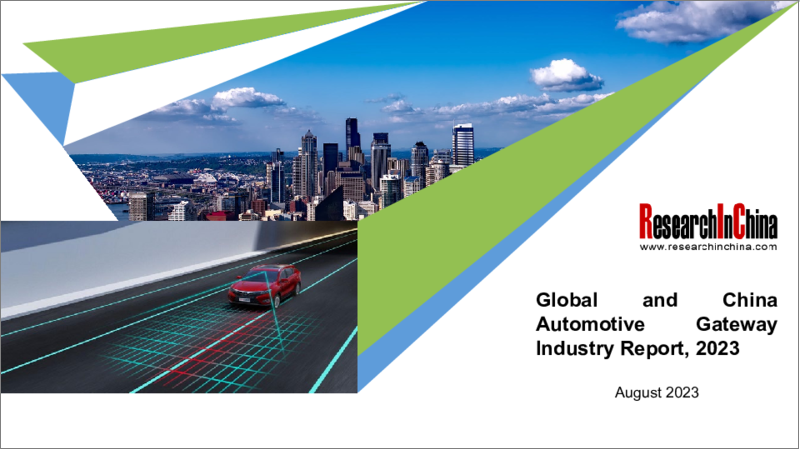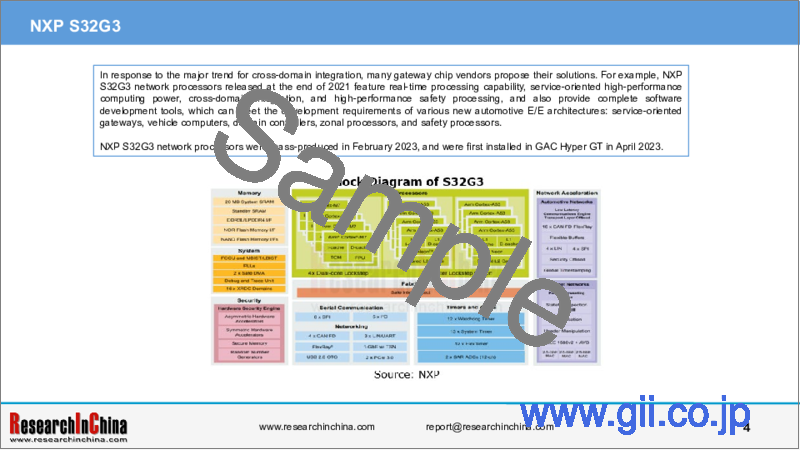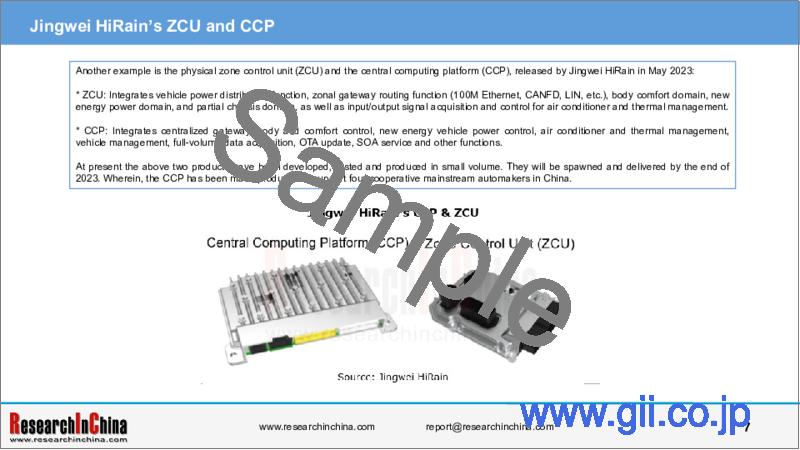|
|
市場調査レポート
商品コード
1337772
世界および中国の車載用ゲートウェイ市場:業界レポート、2023年Global and China Automotive Gateway Industry Report, 2023 |
||||||
| 世界および中国の車載用ゲートウェイ市場:業界レポート、2023年 |
|
出版日: 2023年08月08日
発行: ResearchInChina
ページ情報: 英文 250 Pages
納期: 即日から翌営業日
|
- 全表示
- 概要
- 目次
統合ゲートウェイは、ゾーンアーキテクチャの重要なトレンドとなっています。車載用ゲートウェイは、自動車の電子/電気アーキテクチャの中核をなすコンポーネントです。車載ネットワークのハブとして、データ伝送、セキュリティ防止・制御、リモート診断などの機能を実現します。
クロスドメイン統合の大きな流れを受けて、多くのゲートウェイチップベンダーがそれぞれのソリューションを提案しています。例えば、2021年末にリリースされるNXP S32G3ネットワークプロセッサは、リアルタイム処理機能、サービス指向の高性能コンピューティング能力、クロスドメイン統合、高性能安全処理機能を備えており、完全なソフトウェア開発ツールも提供しているため、サービス指向ゲートウェイ、車両コンピュータ、ドメインコントローラ、ゾーンプロセッサ、安全プロセッサなど、さまざまな新しい自動車E/Eアーキテクチャの開発要件を満たすことができます。
NXP S32G3ネットワークプロセッサは2023年2月に量産され、2023年4月にGAC Hyper GTに初めて搭載されました。
2022年7月に発表されたG9HチップSemiDriveは、主に次世代高性能セントラルゲートウェイ、車両コンピューティングユニット、クロスドメインコントローラなどの場面で使用されます。G9Hは、ボディ・ネットワーク・インターフェースに加えて、1チャネルMIPI DSIおよび2チャネルMIPI CSIを含むビデオ入出力インターフェースもサポートしています。PowerVRの高性能3D GPUと組み合わせることで、G9Hは3Dクラスタ、DMSおよびその他の機能を中央ゲートウェイに統合でき、システムのBOMコストをさらに低減できます。
ゲートウェイのサプライヤーは、独立ゲートウェイから統合ゲートウェイに徐々に移行しています。主な統合モードには、ゲートウェイとボディドメイン間の統合、ゲートウェイとゾーンコントローラ間の統合、ゲートウェイと中央コンピュータ間の統合があります。2023年には、かなりの数のサプライヤーが統合ゲートウェイソリューションを発表しています。
当レポートでは、世界および中国の車載用ゲートウェイ市場について調査し、市場の概要とともに、開発動向と業界チェーン、および市場に参入する企業のプロファイルなどを提供しています。
目次
第1章 車載用ゲートウェイ業界の概要
- 車載用ゲートウェイのコンセプト
- 自動車ネットワークにおけるゲートウェイの役割
- 現段階のゲートウェイ展開
- ゲートウェイの歴史と分類
- ゲートウェイの価格比較
第2章 車載用ゲートウェイの開発動向と業界チェーン
- 車載用ゲートウェイに関するポリシー
- 車載用ゲートウェイの開発動向
- 車載用ゲートウェイ業界チェーン
第3章 車載用ゲートウェイのサプライヤー
- Continental
- Bosch
- Aptiv
- Lear Corporation
- Micron
- TTTech
- FEV
- UAES
- Neusoft
- Jingwei HiRain
- Ofilm
- ZLG
- Yaxon
- Inhand
- Inchtek
第4章 車載用ゲートウェイチップベンダー
- NXP
- ST
- Renesas
- TI
- Infineon
- SemiDrive
- C*Core Technology
第5章 車載用ゲートウェイセキュリティソフトウェア企業
- EB
- ETAS
- KPIT
- Arilou
- GuardKNOX
- EnjoyMove
Automotive gateway research: integrated gateways have become an important trend in zonal architecture.
Automotive gateway is a core component in the automotive electronic/electrical architecture. As the hub of in-vehicle networks, it enables such functions as data transmission, security prevention and control, and remote diagnostics.
As E/E architecture evolves from the distributed to the centralized domain architecture, gateway also changes accordingly. Its evolution route is as follows:
- Phase I: Conventional CAN gateway in distributed architecture
- Phase II: Central gateway in domain-centralized architecture
- Phase III: Distributed gateway in zonal architecture
1. Conventional CAN gateway in distributed architecture
Phase I: the distributed ECU architecture means that many single functional ECUs provide hardware/software solutions. These functional ECU clusters (e.g. power, chassis, body, safety and IVI systems) are combined together and connected via conventional bus systems such as CAN, LIN or FlexRay™. While sensors and actuators are directly connected to the ECUs, the interaction between domains is realized through CAN gateways.
2. Central gateway in domain-centralized architecture
Phase II: the "domain" of a domain controller generally refers to functional domains which fall into: Powertrain, Chassis Control, Body Control, Entertainment System (Cockpit), and ADAS. Systems in these domains are interconnected still using CAN and FlexRay communication buses. For inter-domain communication, the Ethernet with higher performance serves as the backbone network for information exchange. In such architecture, a central gateway is needed for inter-domain communication. This gateway allows for data exchange with OEM vehicle clouds, and is thus regarded as a "service gateway".
3. Distributed gateway in zonal architecture
Phase III: in the zonal architecture, the central gateway will evolve into a HPC or a central computer, while the domain gateways will evolve into zonal gateways. The gateway is not only responsible for routing of in-vehicle network communication buses, but also takes charge of more complex functions, for example, data association and processing between safety and functional domains (e.g., powertrain, chassis and safety, body control, IVI and ADAS) via the MCU+SoC computing platform. The biggest benefit offered by this architecture is to greatly reduce wiring harnesses and thus cut down the weight and cost by about 30%.
Currently, gateways are in a transitional phase from centralized gateways in domain centralized architecture to distributed gateways in zonal architecture.
In response to the major trend for cross-domain integration, many gateway chip vendors propose their solutions. For example, NXP S32G3 network processors released at the end of 2021 feature real-time processing capability, service-oriented high-performance computing power, cross-domain integration, and high-performance safety processing, and also provide complete software development tools, which can meet the development requirements of various new automotive E/E architectures: service-oriented gateways, vehicle computers, domain controllers, zonal processors, and safety processors.
NXP S32G3 network processors were mass-produced in February 2023, and were first installed in GAC Hyper GT in April 2023.
The G9H chip SemiDrive unveiled in July 2022 is mainly used in such scenarios as next-generation high-performance central gateways, vehicle computing units, and cross-domain controllers. In addition to body network interfaces, G9H also supports video input/output interfaces, including 1-channel MIPI DSI and 2-channel MIPI CSIs. Coupled with PowerVR's high-performance 3D GPU, G9H can integrate 3D cluster, DMS and other features into the central gateway, further lowering the BOM cost of the system.
Gateway suppliers make a gradual shift to integrated gateways from independent gateways. The main integration modes include integration between gateways and body domains, between gateways and zone controllers, and between gateways and central computer. In 2023, quite a few suppliers have announced integrated gateway solutions.
Examples include the cross-domain central computing platform product for next-generation E/E architectures, released by UAES in April 2023. This solution integrates central gateway, body control, power and other functional domains, and Neusoft Reach provides underlying software and middleware development support.
Another example is the physical zone control unit (ZCU) and the central computing platform (CCP), released by Jingwei HiRain in May 2023:
- ZCU: Integrates vehicle power distribution function, zonal gateway routing function (100M Ethernet, CANFD, LIN, etc.), body comfort domain, new energy power domain, and partial chassis domain, as well as input/output signal acquisition and control for air conditioner and thermal management.
- CCP: Integrates centralized gateway, body and comfort control, new energy vehicle power control, air conditioner and thermal management, vehicle management, full-volume data acquisition, OTA update, SOA service and other functions.
At present the above two products have been developed, tested and produced in small volume. They will be spawned and delivered by the end of 2023. Wherein, the CCP has been mass-produced to support four cooperative mainstream automakers in China.
As gateway chip and integrated gateway technologies mature, OEMs race to implement their "quasi-centralized" architecture solutions on production models, most of which will be rolled out during 2022-2024.
Table of Contents
1 Overview of Automotive Gateway Industry
- 1.1 Automotive Gateway Concept
- 1.2 The Role of Gateways in Automotive Networks
- 1.3 Gateway Deployment in Current Stage
- 1.4 History and Classification of Gateways
- 1.4.1 Classification of Automotive Gateways - Conventional CAN Gateway
- 1.4.2 Conventional CAN Gateway Corresponds to Distributed ECU Architecture
- 1.4.3 Classification of Automotive Gateway - Centralized Gateway
- 1.4.4 Centralized Gateway Corresponds to Domain Centralized Architecture
- 1.4.5 Domain Centralized Architecture and Centralized Gateway Generate Service-oriented Gateway
- 1.4.6 Service-oriented Gateway Will Accelerate the Evolution of Future Vehicle Architecture
- 1.4.7 Domain Centralized Architecture and Centralized Gateway Generate Integrated Gateway
- 1.4.8 Classification of Automotive Gateways - Distributed Gateway
- 1.4.9 Distributed Gateway Corresponds to Zonal Architecture
- 1.4.10 Evolution of Domain Centralized Architecture to Vehicle Centralized Architecture
- 1.5 Gateway Price Comparison
2 Development Trends and Industry Chain of Automotive Gateway
- 2.1 Policies Concerning Automotive Gateway
- 2.2 Development Trends to Automotive Gateway
- 2.2.1 Development Trends of Network
- 2.2.2 Development Trends of Gateway
- 2.2.3 Gateway Chip Trend 1
- 2.2.4 Gateway Chip Trend 2
- 2.3 Automotive Gateway Industrial Chain
- 2.3.1 Summary on Gateway Suppliers
- 2.3.2 Summary on Gateway Chip Companies
- 2.3.3 Summary on Gateway Security Software Companies
3 Automotive Gateway Suppliers
- 3.1 Continental
- 3.1.1 Profile
- 3.1.2 Operation
- 3.1.3 Automotive Gateway
- 3.1.4 Body HPC
- 3.1.5 Cross-domain High Performance Computer
- 3.1.6 Body HPC SOP Plan
- 3.1.7 E/E Architecture
- 3.2 Bosch
- 3.2.1 Profile
- 3.2.2 Operation
- 3.2.3 Gateway Development History and Functions
- 3.2.4 Vehicle Central Gateway: Passenger Cars
- 3.2.5 Vehicle Central Gateway: Commercial Vehicles
- 3.2.6 Bosch's Five-Domain Architecture for Vehicle Control
- 3.3 Aptiv
- 3.3.1 Profile
- 3.3.2 Gateway Products
- 3.3.3 Gateway Computing Platform
- 3.3.4 SVA
- 3.3.5 Development Route of SVA
- 3.4 Lear Corporation
- 3.4.1 Profile
- 3.4.2 Gateway Products
- 3.4.3 Gateway Business Layout
- 3.5 Micron
- 3.6 TTTech
- 3.6.1 Profile
- 3.6.2 Ethernet Technology and Products
- 3.6.3 Auto N4
- 3.7 FEV
- 3.7.1 Profile
- 3.7.2 Gateway Product Iterations
- 3.7.3 Comparison between Gateway Products
- 3.7.4 Application of Gateway Products
- 3.8 UAES
- 3.8.1 Profile
- 3.8.2 Development Strategy
- 3.8.3 Gateway Products
- 3.8.4 Connected Gateway - Main Application Scenarios of GAW 3.0
- 3.8.5 Connected /Ethernet Gateway Platform Project
- 3.8.6 E/E Architecture
- 3.8.7 Vehicle Computing Platform (VCP)
- 3.8.8 First Generation Vehicle Computing Platform - VCP1.0
- 3.8.9 Body Domain Controller
- 3.8.10 Vehicle Fusion System Solution
- 3.8.11 Development of Next Generation Cross-Domain Central Computing Platforms
- 3.9 Neusoft
- 3.9.1 Profile
- 3.9.2 Automotive Business and Operation
- 3.9.3 Automotive Network Security Products
- 3.9.4 Intelligent Cockpit Architecture
- 3.9.5 Universal Domain Controller
- 3.9.6 Autonomous Driving Central Computing Platform - X-Center
- 3.9.7 NetEye Intelligent Connected Vehicle Safety Solution (S-Car)
- 3.10 Jingwei HiRain
- 3.10.1 Profile
- 3.10.2 Operation
- 3.10.3 Gateway Products
- 3.10.4 Development History of Gateway Products
- 3.10.5 Zone Controllers (Integrating Zonal Gateway Routing Function)
- 3.10.6 Central Computing Platform (Integrating Central Gateway)
- 3.10.7 Vehicle E/E Development
- 3.11 Ofilm
- 3.11.1 Profile
- 3.11.2 Operation
- 3.11.3 5th Generation Body Domain Controller: Integrated Gateway
- 3.11.4 5th Generation Body Domain Controller: Advantages and Functions
- 3.11.5 5th Generation Body Domain Controller: Implementation
- 3.12 ZLG
- 3.12.1 Profile
- 3.12.2 Operating Business
- 3.12.3 Intelligent Connected Solutions
- 3.12.4 Vehicle Ethernet Solutions
- 3.12.5 The First Vehicle Ethernet Product - VBNET Series
- 3.12.6 Advantages of VBNET Series Products
- 3.13 Yaxon
- 3.13.1 Profile
- 3.13.2 Summary on Gateway Products
- 3.13.3 Introduction to Gateway Products
- 3.14 Inhand
- 3.14.1 Profile
- 3.14.2 Vehicle Gateway Products: InVehicle G814
- 3.14.3 Vehicle Gateway Products: InVehicle G710
- 3.14.4 Vehicle Gateway Products: InVehicle T310
- 3.15 Inchtek
- 3.15.1 Profile
- 3.15.2 Operation
- 3.15.3 Summary on Vehicle Gateway Products
- 3.15.4 Vehicle Gateway Product: L3000
4 Automotive Gateway Chip Vendors
- 4.1 NXP
- 4.1.1 Profile
- 4.1.2 Gateway Frame Diagram
- 4.1.3 S32G Automotive Network Processors
- 4.1.4 Introduction to S32G2 Chips
- 4.1.5 Introduction to S32G3 Chips
- 4.2 ST
- 4.2.1 Profile
- 4.2.2 Operation in 2023Q1
- 4.2.3 Main Products
- 4.2.4 Automotive Gateway Chips
- 4.2.5 Automotive Gateway Chips - SPC5 Series
- 4.2.6 Overview of SPC5 MCU Ecosystem
- 4.2.7 SPC5 MCU Development Support
- 4.2.8 Stellar Series Platforms
- 4.2.9 Stellar Series Product Categories
- 4.4.10 Smart Gateway Platform (SGP)
- 4.2.11 Automotive Gateway Solutions
- 4.2.12 Competitive Edges in Automotive Gateway
- 4.3 Renesas
- 4.3.1 Profile
- 4.3.2 R-Car Platform
- 4.3.3 Gateway Chip: R-Car-S4
- 4.3.4 Application 1 - Automotive Gateway Solution Based on R-Car S4
- 4.3.5 Application 2 - Vehicle Computer 4 (VC4) Based on R-Car S4
- 4.3.6 Application 3 - Communication Gateway and DVR/DMS System Integrated Solution
- 4.3.7 R-Car S4 Whitebox SDK
- 4.3.8 Develop New Technology for Vehicle Communication Gateway SoCs
- 4.3.9 Gateway Product Route
- 4.3.10 Next Generation E/E Architecture
- 4.4 TI
- 4.4.1 Profile
- 4.4.2 Automotive Chips
- 4.4.3 Jacinto 7 Platform
- 4.4.4 Gateway Chip Products
- 4.4.5 Gateway Reference Designs
- 4.4.6 Gateway Roadmap
- 4.5 Infineon
- 4.5.1 Profile
- 4.5.2 Development History of 32-bit TriCore™ Microcontrollers
- 4.5.3 AURIX™ TC2xx Family
- 4.5.4 AURIX™ TC3xx Family
- 4.5.5 AURIX™ TC4xx Family
- 4.5.6 AURIX™ TC4x Architecture
- 4.5.7 Continental Develops E/E Architecture Modular Platform Using Infineon's High-End Microcontroller AURIX TC4
- 4.5.8 Central Gateway
- 4.5.9 Central Gateway Reference Design
- 4.5.10 Body Control Module Integrated Gateway
- 4.6 SemiDrive
- 4.6.1 Profile
- 4.6.2 Gateway Chip - G9 Series
- 4.6.3 The Latest Chip Product of G9 Series - G9H
- 4.6.4 Advantages of G9H
- 4.6.5 Solution Reference Design
- 4.6.6 Central Computing Architecture
- 4.7 C*Core Technology
- 4.7.1 Profile
- 4.7.2 Automotive Electronics Chip Products
- 4.7.3 Launched AUTOSAR CP Solution Together with Jingwei HiRain
- 4.7.4 Cooperation in Automotive Field and Future Plan
5 Automotive Gateway Security Software Companies
- 5.1 EB
- 5.1.1 Profile
- 5.1.2 Integrated Software Platform - EB xelor
- 5.1.3 EB tresos
- 5.1.4 EB corbos
- 5.1.5 EB zoneo
- 5.1.6 Cooperation Cases
- 5.2 ETAS
- 5.2.1 Profile
- 5.2.2 AUTOSAR Adaptive Platform
- 5.2.3 Cyber Security Products (ESCRYPT)
- 5.2.4 ESCRYPT CycurGATE - High Performance Automotive Ethernet/IP Firewall and Router Solution
- 5.2.5 ESCRYPT CycurHSM - Safety Software for Control Units
- 5.2.6 Application Cases of ESCRYPT CycurHSM
- 5.3 KPIT
- 5.3.1 Profile
- 5.3.2 KPIT AUTOSAR
- 5.3.3 AUTOSAR Classic Platform - KSAR Classic
- 5.3.4 AUTOSAR Adaptive Platform - KSAR Adaptive
- 5.3.5 Recent Dynamics in Cooperation
- 5.4 Arilou
- 5.4.1 Profile
- 5.4.2 Intrusion Detection and Prevention System (IDPS)
- 5.4.3 Parallel Intrusion Prevention System (PIPS)
- 5.4.4 Ethernet Security Hub (ESH), Backend Solutions and Cooperation Cases
- 5.5 GuardKNOX
- 5.5.1 Profile
- 5.5.2 Secure SOA Framework
- 5.5.3 GuardKnox CommEngine™
- 5.5.4 GuardKnox Communication LockdownTM
- 5.5.5 Recent Dynamics in Cooperation
- 5.6 EnjoyMove
- 5.6.1 Profile
- 5.6.2 Intelligent Driving High Performance Computing Software Platform - EMOS
- 5.6.3 Intelligent Domain Control Solution
- 5.6.4 High Performance Computing Cluster Solution (XCG)
- 5.6.5 Open Source Intelligent Application Development Tool Suite@
- 5.6.6 Cooperation Dynamics and Partners




